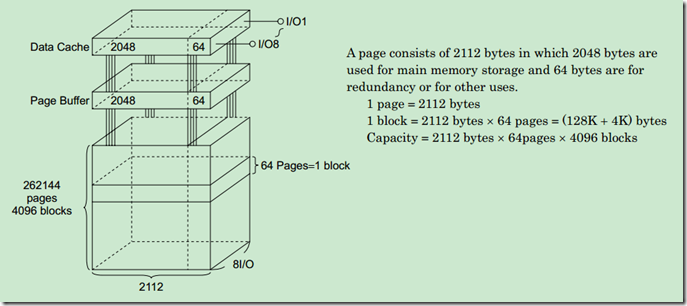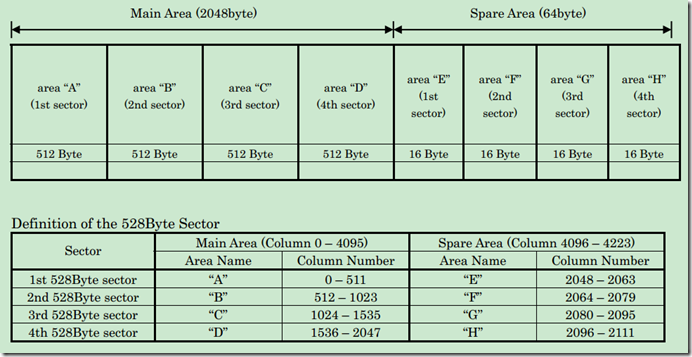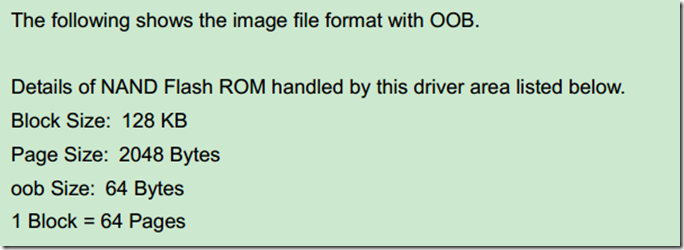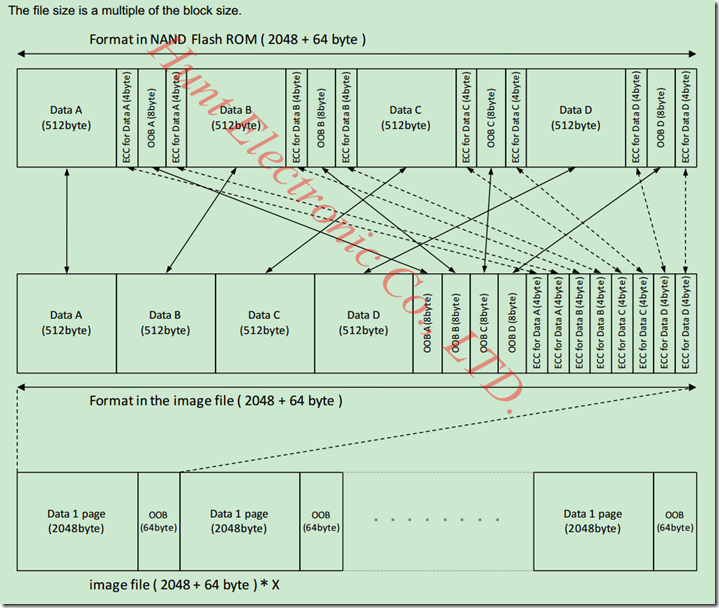以TC58NVG2S3ETA00 为例:
下面是它的一些物理参数:
图一
图二
图三
图四
图五
图6-0
图6-1
说明一下,在图6-1中中间的那个布局表可以看做是实际的NandFlash一页数据的布局,其中Data区域用于存放有效的数据,也就是我们可以通过类似read、write、pread、pwrite可以访问的区域,那每页中的64字节的OOB区域是无法通过前面的几个函数访问的,他们会自动跳过OOB区域,访问OOB区域需要借助特殊的命令。
简单说明一下:Data A(512B)对应的ECC校验码存放在ECC for Data A(4 byte)中,OOB A (8byte) 对应的ECC校验码存放在紧接着的下一个ECC for Data A(4 byte)中,虽然用4字节存放ECC,但是对于本例,ECC只占3个字节。在实际使用中如果解决方案中用不到OOB A/B/C/D,可以不用管他们对应的ECC,只需要关心Data区域对应的ECC。如果使能了硬件ECC,硬件会自动把计算生成的ECC写到OOB中。可以参考http://www.cnblogs.com/pengdonglin137/p/3467960.html 。
读NandFlash需要按页读,即一次读一页;写NandFlash需要按页写,即每次写一页;擦除NandFlash需要按块擦,即每次要擦除一块。
对与NandFlash等块设备的访问操作,mtd-utils工具集中提供了非常好的支持(可以到http://www.linux-mtd.infradead.org/进行了解),要使用mtd-utils工具集首先需要搞到mtd-utils的源码,并且使用目标设备上的交叉工具编译链进行编译,具体方法可以参考:http://www.cnblogs.com/pengdonglin137/p/3415550.html,其中介绍了如何生成可以再目标板上运行的mtd-utils工具。关于mtd-utils工具的使用可以参考:http://www.cnblogs.com/pengdonglin137/p/3415663.html 其中介绍了mtd-utils中常用的工具。
我们可以参考mtd-utils中工具的实现,从而完成在自己的应用程序中实现对NandFlash的操作。常用的命令如下:
#define MEMGETINFO _IOR('M', 1, struct mtd_info_user)
#define MEMERASE _IOW('M', 2, struct erase_info_user)
#define MEMWRITEOOB _IOWR('M', 3, struct mtd_oob_buf)
#define MEMREADOOB _IOWR('M', 4, struct mtd_oob_buf)
#define MEMLOCK _IOW('M', 5, struct erase_info_user)
#define MEMUNLOCK _IOW('M', 6, struct erase_info_user)
#define MEMGETREGIONCOUNT _IOR('M', 7, int)
#define MEMGETREGIONINFO _IOWR('M', 8, struct region_info_user)
#define MEMSETOOBSEL _IOW('M', 9, struct nand_oobinfo)
#define MEMGETOOBSEL _IOR('M', 10, struct nand_oobinfo)
#define MEMGETBADBLOCK _IOW('M', 11, __kernel_loff_t)
#define MEMSETBADBLOCK _IOW('M', 12, __kernel_loff_t)
#define OTPSELECT _IOR('M', 13, int)
#define OTPGETREGIONCOUNT _IOW('M', 14, int)
#define OTPGETREGIONINFO _IOW('M', 15, struct otp_info)
#define OTPLOCK _IOR('M', 16, struct otp_info)
#define ECCGETLAYOUT _IOR('M', 17, struct nand_ecclayout_user)
#define ECCGETSTATS _IOR('M', 18, struct mtd_ecc_stats)
#define MTDFILEMODE _IO('M', 19)
#define MEMERASE64 _IOW('M', 20, struct erase_info_user64)
#define MEMWRITEOOB64 _IOWR('M', 21, struct mtd_oob_buf64)
#define MEMREADOOB64 _IOWR('M', 22, struct mtd_oob_buf64)
#define MEMISLOCKED _IOR('M', 23, struct erase_info_user)
打开设备
这里需要注意的是,打开的设备结点是/dev/mtd?,而不是/dec/mtdblock?,原因可以参考:
http://www.cnblogs.com/pengdonglin137/p/3316523.html,其中介绍了mtd与mtdblock的区别。
获取设备信息
__u32 erasesize;
__u32 writesize;
__u32 oobsize;// Amount of OOB data per block (e.g. 16)
/*
The below two fields are obsolete and broken, do not use them * (TODO: remove at some point) */
__u32 ecctype; __u32 eccsize; }; struct mtd_info_user mtd;
擦除NandFlash
#include <mtd/mtd-abi.h>
#include <linux/types.h>
struct erase_info_user {
__u32 start;
__u32 length;
};
typedef struct erase_info_user erase_info_t;
erase_info_t erase;
int isNAND, bbtest = 1;
erase.length = DevInfo->erasesize;
// erase.length 表示的是擦除大小,也就是一块的大小,如128KB
// DevInfo->size 为某个/dev/mtdx的大小
// erasse.start应该是按块对齐递增
isNAND = (DevInfo->typenum== MTD_NANDFLASH) ? 1 : 0;
for (erase.start = 0; erase.start < DevInfo->size; erase.start += DevInfo->erasesize)
{
if (bbtest)
{
loff_t offset = erase.start;
int ret = ioctl(DevInfo->fd, MEMGETBADBLOCK, &offset); //判断是不是坏块
if (ret > 0)
{
if (!quiet)
DEBUG ("
Skipping bad block at 0x%08x
", erase.start);
continue;//发现是坏块,应该跳过
}
else if (ret < 0)
{
if (errno == EOPNOTSUPP)
{
bbtest = 0;
if (isNAND)
{
fprintf(stderr, "%s: Bad block check not available
", DevInfo->dir);
return 1;
}
}
else
{
fprintf(stderr, "
%s: MTD get bad block failed: %s
", DevInfo->dir, strerror(errno));
return 1;
}
}
}
if (!quiet)
{
fprintf(stderr, "
Erasing %d Kibyte @ %x -- %2llu %% complete.",
(DevInfo->erasesize) / 1024, erase.start,
(unsigned long long) erase.start * 100 / (DevInfo->size));
}
if (ioctl(DevInfo->fd, MEMERASE, &erase) != 0) //执行擦除操作
{
fprintf(stderr, "
%s: MTD Erase failure: %s
", DevInfo->dir,strerror(errno));
continue;
}
}
写NandFlash
这里分为写数据区和写OOB区
写数据区,对于本例一次要写一页,也就是2KB,写OOB区,对于本例可以操作的只有32字节,剩下的32字节用于存放ECC。
struct mtd_oob_buf {
__u32 start;
__u32 length;
unsigned char *ptr;
};
int nandwrite(DeviceInfo* meminfo)
{
int imglen = 0, pagelen;
bool baderaseblock = false;
int blockstart = -1;
loff_t offs;
int ret, readlen;
unsigned char tmp_oob[32];//OOB A/B/C/D,一共32字节
struct mtd_oob_buf OOB_INFO ;
sourceaddr = meminfo->head->file_offset; //要读的部分在镜像文件中的偏移量
sourcelen = meminfo->head->size; //要读的部分的大小
int num_to_read = 0;
OOB_INFO.start = 0;
OOB_INFO.length = meminfo->head->oob_usr_length; //32字节,用户可以访问的OOB的大小,也就是OOB A/B/C/D
OOB_INFO.ptr = tmp_oob;
pagelen = meminfo->writesize; // 2KB
imglen = sourcelen; // 镜像文件的长度
mtdoffset = meminfo->head->flash_offset; //要写的部分在/dev/mtdx中的偏移量,以字节为单位
/* Determine if we are reading from standard input or from a file. */
if (0 == sourceaddr) {
DEBUG("Have no sourceaddr return ****************************
");
return 1;
}
// Check, if length fits into device
if ( ((imglen / pagelen) * meminfo->writesize) > (meminfo->size - mtdoffset)) {
fprintf (stderr, "Image %d bytes, NAND page %d bytes, OOB area %u bytes, device size %u bytes
",
imglen, pagelen, meminfo->writesize, meminfo->size);
perror ("Input file does not fit into device");
goto closeall;
}
while ((imglen>0) && (mtdoffset < meminfo->size))
{
//blockstart 将来存放的是正在写的那块的起始地址,并且是块对齐的
//mtdoffset 表示的是在某个mtd设备中的整体偏移量,可以按块递增,也可以按页递增
//设置blockstart的目的是:
// 假如检测到一个好的块,开始进行写操作,但是在写的过程中发生了写错误,可以认为这块已经
//是坏块了,需要重新再找一个好的块,然后重新写入之前的数据,因此需要知道刚才那个坏块的起始地址
// mtdoffset & (~meminfo->erasesize + 1) 这种获取块起始地址的算法值得借鉴
while (blockstart != (mtdoffset & (~meminfo->erasesize + 1)))
{
blockstart = mtdoffset & (~meminfo->erasesize + 1);
offs = blockstart;
baderaseblock = false;
if (!quiet)
{
fprintf (stderr, "
Writing data to block %d at offset 0x%x",
blockstart / meminfo->erasesize, blockstart);
}
/* Check all the blocks in an erase block for bad blocks */
// meminfo->fd 是某个/dev/mtdx的文件描述符
do {
if ((ret = ioctl(meminfo->fd, MEMGETBADBLOCK, &offs)) < 0)
{
perror("ioctl(MEMGETBADBLOCK)");
goto closeall;
}
if (ret == 1)
{
baderaseblock = true;
if (!quiet)
{
fprintf (stderr, "Bad block at %x block(s) "
"from %x will be skipped
",
(int) offs, blockstart);
}
}
if (baderaseblock)
{
mtdoffset = blockstart + meminfo->erasesize;
}
offs += meminfo->erasesize;
} while ( offs < blockstart + meminfo->erasesize );
}
readlen = meminfo->writesize; // 2KB
if (0 != sourceaddr)
{
if((meminfo->head->imageType == YAFFS) || (meminfo->head->imageType == OOB_RAW))
{
writeoob = true;
}
else
{
writeoob = false;
}
memset(writebuf, 0xff, sizeof(writebuf));
if(imglen < readlen)
{
num_to_read = imglen;
}
else
{
num_to_read = readlen;
}
// 从镜像文件中偏移量为sourceaddr处读取num_to_read个字节到writebuf中
// ALLIMAGEFD 为镜像文件的文件描述符
if(pread(ALLIMAGEFD, writebuf, num_to_read, sourceaddr) < 0)
{
perror("fail to pread
");
return -1;
}
sourceaddr += num_to_read;
if(writeoob)
{
memset(tmp_oob, 0xff , OOB_FREE_MAX);
// 从镜像文件中偏移量为sourceaddr+meminfo->head->oob_usr_offset处读取meminfo->head->oob_usr_length个字节到tmp_oob中,其中meminfo->head->oob_usr_offset是OOB A相对与OOB区域的偏移量,meminfo->head->oob_usr_length 在本例中为32字节
if(pread(ALLIMAGEFD, tmp_oob, meminfo->head->oob_usr_length, sourceaddr+meminfo->head->oob_usr_offset) < 0)
{
perror("fail to pread
");
return -1;
}
sourceaddr += meminfo->oobsize;
}
}
if(-1 == pwrite(meminfo->fd, writebuf, meminfo->writesize, mtdoffset)) //写NandFlash
{
/*
下面这段程序所完成的就是刚才所说的在写之前检测到是好块,但是在写的过程出现了写错误,
这个时候需要完成?如下流程:
1、计算已经在当前块上写入多少内容,比如下面的rewind_blocks是为了计算在当前块上已经写了多少页,
这里需要注意的是;rewind_bytes又加了一个readlen,也就是一页的大小,目的是保证sourceaddr的可以
回退到刚开始写当前块是sourceaddr的值,可以看到在上面的程序中每次将要写的内容读到writebuf后,
sourceaddr已经进行了自增操作,并没有保证刚读到writebuf中的内容可以成功写入。
但是mtdoffset进行自增的前提是偏移量为mtdoffset的页写成功。其实程序可以这么改进:
将sourceaddr的自增操作跟mtdoffset的自增操作放在一起,此时rewind_bytes就不需要再加readlen了。
对于oob,一般只有yaffs镜像中有oob,而向cramfs、jffs2、ubifs这没有,如果有oob也需要对
rewind_byte进行处理
2、对当前块进行擦除
3、如果需要进行坏块标记,则将当前块标记为坏块
4、将mtdoffset指向当前块的下一块起始地址
5、恢复imglen为刚开始处理当前块时的值,由于imglen也是保证当前页成功写入后才自减,所以只需要加
上rewind_blocks即可
*/
int rewind_blocks;
off_t rewind_bytes;
erase_info_t erase;
perror("ioctl(MEMEWRITEPAGE)");
/* Must rewind to blockstart if we can */
rewind_blocks = (mtdoffset - blockstart) / meminfo->writesize; /* Not including the one we just attempted */
rewind_bytes = (rewind_blocks * meminfo->writesize) + readlen;
if (writeoob)
{
rewind_bytes += (rewind_blocks + 1) * meminfo->oobsize;
}
sourceaddr -= rewind_bytes;
erase.start = blockstart;
erase.length = meminfo->erasesize;
fprintf(stderr, "Erasing failed write from %08lx-%08lx
",
(long)erase.start, (long)erase.start+erase.length-1);
if (ioctl(meminfo->fd, MEMERASE, &erase) != 0)
{
perror("MEMERASE");
goto closeall;
}
if (markbad)
{
loff_t bad_addr = mtdoffset & (~meminfo->erasesize + 1);
fprintf(stderr, "Marking block at %08lx bad
", (long)bad_addr);
if (ioctl(meminfo->fd, MEMSETBADBLOCK, &bad_addr)) {
perror("MEMSETBADBLOCK");
/* But continue anyway */
}
}
mtdoffset = blockstart + meminfo->erasesize;
imglen += rewind_blocks * meminfo->writesize;
if(writeoob)
{
imglen += rewind_blocks * meminfo->oobsize;
}
continue;
}
imglen -= readlen;
if(writeoob)
{
imglen -= meminfo->oobsize;
OOB_INFO.start = mtdoffset;
if (ioctl(meminfo->fd, MEMWRITEOOB, &OOB_INFO))
{
perror("fail to ioctl");
}
}
mtdoffset += meminfo->writesize;
}
closeall:
if ((imglen > 0))
{
perror ("Data was only partially written due to error
");
exit (EXIT_FAILURE);
}
return EXIT_SUCCESS;
}
对于写NandFlash,有的设备支持一次性把data和oob一块写进去。代码如下:
struct mtd_info_user {
uint8_t type;
uint32_t flags;
uint32_t size; // Total size of the MTD
uint32_t erasesize;
uint32_t writesize;
uint32_t oobsize; // Amount of OOB data per block (e.g. 16)
/* The below two fields are obsolete and broken, do not use them
* (TODO: remove at some point) */
uint32_t ecctype;
uint32_t eccsize;
};
struct mtd_epage_buf
{
unsigned long long start;
unsigned long data_len;
unsigned long oob_len;
unsigned char * data_ptr;
unsigned char * oob_ptr;
};
#define MEMEWRITEPAGE _IOWR('M', 23, struct mtd_epage_buf)
#define MAX_PAGE_SIZE 8192
#define MAX_OOB_SIZE 512
/*
* Buffer array used for writing data
*/
unsigned char writebuf[MAX_PAGE_SIZE];
char oobbuf[MAX_OOB_SIZE];
int nandwrite(int argc, char * const argv[])
{
/*int cnt = 0;*/
int fd = -1;
/*int ifd = -1;*/
int imglen = 0, pagelen;
bool baderaseblock = false;
int blockstart = -1;
struct mtd_info_user meminfo;
struct mtd_epage_buf eccbuf;
loff_t offs;
int ret, readlen;
/*process_options(argc, argv);*/
mtdoffset = 0; /* reinit */
erase_buffer(oobbuf, sizeof(oobbuf));
if (pad && writeoob) {
fprintf(stderr, "Can't pad when oob data is present.
");
exit (EXIT_FAILURE);
}
/* Open the device */
if ((fd = open(mtd_device, O_RDWR)) == -1) {
perror(mtd_device);
exit (EXIT_FAILURE);
}
/* Fill in MTD device capability structure */
if (ioctl(fd, MEMGETINFO, &meminfo) != 0) {
perror("MEMGETINFO");
close(fd);
exit (EXIT_FAILURE);
}
/* Determine if we are reading from standard input or from a file. */
if (NULL == sourceaddr) {
DEBUG("Have no sourceaddr return ****************************
");
return 0;
}
pagelen = meminfo.writesize + ((writeoob) ? meminfo.oobsize : 0);
/*
* For the standard input case, the input size is merely an
* invariant placeholder and is set to the write page
* size. Otherwise, just use the input file size.
*
* TODO: Add support for the -l,--length=length option (see
* previous discussion by Tommi Airikka <tommi.airikka@ericsson.com> at
* <http://lists.infradead.org/pipermail/linux-mtd/2008-September/
* 022913.html>
*/
imglen = sourcelen;
// Check, if file is page-aligned
if ((!pad) && ((imglen % pagelen) != 0)) {
fprintf (stderr, "Input file is not page-aligned. Use the padding "
"option.
");
goto closeall;
}
// Check, if length fits into device
if ( ((imglen / pagelen) * meminfo.writesize) > (meminfo.size - mtdoffset)) {
fprintf (stderr, "Image %d bytes, NAND page %d bytes, OOB area %u bytes, device size %u bytes
",
imglen, pagelen, meminfo.writesize, meminfo.size);
perror ("Input file does not fit into device");
goto closeall;
}
const int allSizeConst = imglen;
/*DEBUG("file:%s, line:%d, imglen:%d, mtdoffset:%d, meminfo.size:%d
",
__FILE__, __LINE__, imglen, mtdoffset, meminfo.size);*/
/*
* Get data from input and write to the device while there is
* still input to read and we are still within the device
* bounds. Note that in the case of standard input, the input
* length is simply a quasi-boolean flag whose values are page
* length or zero.
*/
while (imglen && (mtdoffset < meminfo.size))
{
// new eraseblock , check for bad block(s)
// Stay in the loop to be sure if the mtdoffset changes because
// of a bad block, that the next block that will be written to
// is also checked. Thus avoiding errors if the block(s) after the
// skipped block(s) is also bad (number of blocks depending on
// the blockalign
while (blockstart != (mtdoffset & (~meminfo.erasesize + 1)))
{
blockstart = mtdoffset & (~meminfo.erasesize + 1);
offs = blockstart;
baderaseblock = false;
if (!quiet)
fprintf (stdout, "Writing data to block %d at offset 0x%x
",
blockstart / meminfo.erasesize, blockstart);
/* Check all the blocks in an erase block for bad blocks */
do {
if ((ret = ioctl(fd, MEMGETBADBLOCK, &offs)) < 0) {
perror("ioctl(MEMGETBADBLOCK)");
goto closeall;
}
if (ret == 1) {
baderaseblock = true;
if (!quiet)
fprintf (stderr, "Bad block at %x block(s) "
"from %x will be skipped
",
(int) offs, blockstart);
}
if (baderaseblock) {
mtdoffset = blockstart + meminfo.erasesize;
}
offs += meminfo.erasesize;
} while ( offs < blockstart + meminfo.erasesize );
}
readlen = meminfo.writesize;
if (NULL != sourceaddr) {
if (pad && (imglen < readlen))
{
readlen = imglen;
erase_buffer(writebuf + readlen, meminfo.writesize - readlen);
}
memcpy(writebuf, sourceaddr, readlen);
sourceaddr += readlen;
}
if (writeoob) {
memcpy(oobbuf, sourceaddr, meminfo.oobsize);
sourceaddr += meminfo.oobsize;
}
eccbuf.data_ptr = writebuf;
eccbuf.data_len = meminfo.writesize;
eccbuf.oob_ptr = oobbuf;
eccbuf.oob_len = meminfo.oobsize;
eccbuf.start = mtdoffset;
if (ioctl(fd, MEMEWRITEPAGE, &eccbuf) != 0)
{
int rewind_blocks;
off_t rewind_bytes;
erase_info_t erase;
perror("ioctl(MEMEWRITEPAGE)");
/* Must rewind to blockstart if we can */
rewind_blocks = (mtdoffset - blockstart) / meminfo.writesize; /* Not including the one we just attempted */
rewind_bytes = (rewind_blocks * meminfo.writesize) + readlen;
if (writeoob)
rewind_bytes += (rewind_blocks + 1) * meminfo.oobsize;
sourceaddr -= rewind_bytes;
erase.start = blockstart;
erase.length = meminfo.erasesize;
fprintf(stderr, "Erasing failed write from %08lx-%08lx
",
(long)erase.start, (long)erase.start+erase.length-1);
if (ioctl(fd, MEMERASE, &erase) != 0) {
perror("MEMERASE");
goto closeall;
}
if (markbad) {
loff_t bad_addr = mtdoffset & (~meminfo.erasesize + 1);
fprintf(stderr, "Marking block at %08lx bad
", (long)bad_addr);
if (ioctl(fd, MEMSETBADBLOCK, &bad_addr)) {
perror("MEMSETBADBLOCK");
/* But continue anyway */
}
}
mtdoffset = blockstart + meminfo.erasesize;
imglen += rewind_blocks * meminfo.writesize;
continue;
}
imglen -= (readlen + meminfo.oobsize);
mtdoffset += meminfo.writesize;
}
closeall:
close(fd);
if ((imglen > 0)) {
perror ("Data was only partially written due to error
");
exit (EXIT_FAILURE);
}
/* Return happy */
return EXIT_SUCCESS;
}
读OOB
读OOB跟写OOB类似,只不过使用的命令是MEMREADOOB。
#include <sys/ioctl.h>
#include <stdio.h>
#include <mtd/mtd-user.h>
#include <sys/types.h>
#include <sys/stat.h>
#include <fcntl.h>
#include <unistd.h>
#include <string.h>
#include <stdlib.h>
#define N 32
#define OFS (0)
#define block_size (128*1024)
#define page_size (2*1024)
int main(int argc, const char *argv[])
{
int fd;
int i, j;
unsigned char oob_data[32] =
{
0x53, 0x50, 0x4c, 0x20, 0, 0xff, 0, 0xff,
0x53, 0x50, 0x4c, 0x20, 0, 0xff, 0, 0xff,
0x53, 0x50, 0x4c, 0x20, 0, 0xff, 0, 0xff,
0x53, 0x50, 0x4c, 0x20, 0, 0xff, 0, 0xff
};
unsigned char oobbuf[N];
struct mtd_oob_buf oob = {0, N, oobbuf};
struct mtd_oob_buf my_oob = {0, N, oob_data};
fd = open("/dev/mtd0", O_RDWR);
if(fd < 0)
{
perror("fail to open
");
exit(-1);
}
if(ioctl(fd, MEMWRITEOOB, &my_oob))
{
perror("fail to ioctl");
exit(-1);
}
memset(oobbuf, 0, sizeof(oobbuf));
oob.start = OFS;
if (ioctl(fd, MEMREADOOB, &oob))
{
perror("fail to ioctl");
exit(-1);
}
for(i=0; i<N; i++)
{
if(i%8 == 0)
{
printf("
");
}
printf("%#x ", oobbuf[i]);
}
printf("
");
close (fd);
return 0;
}
以上只是本人在工作中遇到的,仅供参考。






